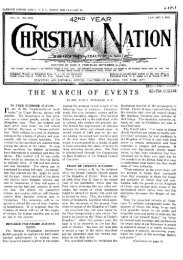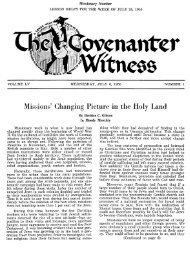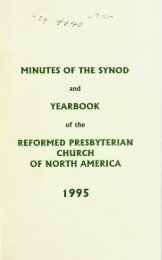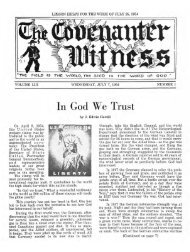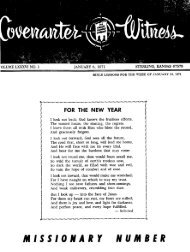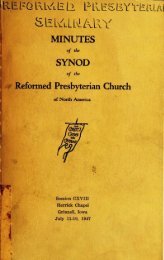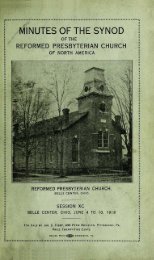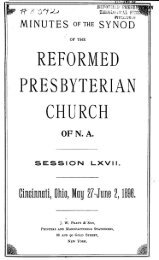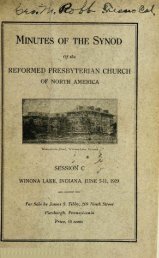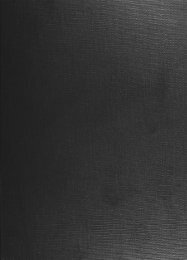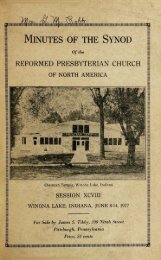Reformed Presbyterian Minutes of Synod 1993
Reformed Presbyterian Minutes of Synod 1993
Reformed Presbyterian Minutes of Synod 1993
- No tags were found...
Create successful ePaper yourself
Turn your PDF publications into a flip-book with our unique Google optimized e-Paper software.
184 <strong>1993</strong> MINUTES OF THE SYNOD OF THELord's Supper. The water, the bread, and the cup have important symbolimeaning, and are to be explained in conjunction with their use.New Testament believers met to worship wherever it was convenient:an upper room, by a river,in a house, in a lecture haU, etc. The exercise<strong>of</strong> the worship <strong>of</strong> God no longer required a special place, or symbolic aids,for Christ now had perfectly revealed the Father (John 1:14,18; Hebrews1:1-3; Colossians 1:15,19; 2:17).There were, however, accommodating factors which were taken intoconsideration in the various places chosen for worship, such as: "furnishings"(in the upper room, Luke 22:12); an undisturbed beautiful setting(outside the city by the river, Acts 16:13); "an upstairs room with manylamps" (in a house, Acts 20:8). The furnishings, beautiful setting, the roomand the lamps were not essential to the worship <strong>of</strong> God, nor were theyincorporated into it. Instead, these things simply accommodated theworship and created an environment suitable for and conducive to worship.Things which merely serve to accommodate the worship <strong>of</strong> believersare external to the worship itself, and therefore have no integral part in it.They may be either present or absent without vitally affecting the worship.These might include such things as pews, lighting, carpet, tables, pulpits,windows (stained glass or plain), paint, decorations, wall hangings,pictures, banners, plaques, flowers, books, clocks, fans, sound systems, airconditioners, etc. Some <strong>of</strong> these "furnishings" may involve religioussymbols or symbolism and yet remain external to the worship itself.There should be a word <strong>of</strong> caution here, as was noted in the report <strong>of</strong>the special judicial committee which reviewed this matter last year.Because it is characteristic <strong>of</strong> the sinful nature <strong>of</strong> man to worship "createdthings more than the Creator" (Romans 1:25), and to depend on the visiblerather than "seeing Him who is invisible" when focusing one's thoughtson God (2 Corinthians 4:11; Hebrews 11:17), any use <strong>of</strong> religioussymbolism in the decor <strong>of</strong> a place used for worship must be done with careand pmdence. It is the responsibility <strong>of</strong> the Session to exercise carefuloversight. History has shown that items having religious significance have<strong>of</strong>ten moved from being merely decor to becoming objects <strong>of</strong> idolatry.HISTORICAL CONSIDERATIONSThe earliest use <strong>of</strong> Christian symbols apparently was in the catacombswhere the dead were buried and worship was conducted secredy. Theempty cross and other symbols were made by the end <strong>of</strong> the secondcentury. Problems soon appeared, such as making the sign <strong>of</strong> the cross asa superstitious custom. When persecution ended in the fourth century andlarge churches were built, they were adorned with many representations <strong>of</strong>



